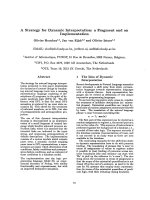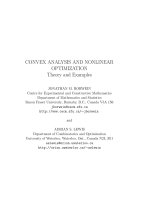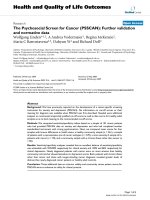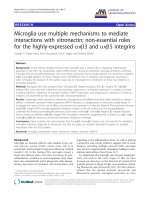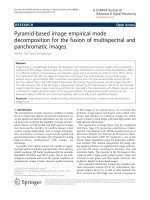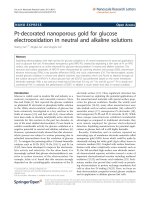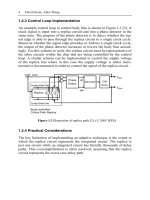Adaptive Techniques for Dynamic Processor Optimization Theory and Practice by Alice Wang and Samuel Naffziger_12 ppt
Bạn đang xem bản rút gọn của tài liệu. Xem và tải ngay bản đầy đủ của tài liệu tại đây (876.98 KB, 19 trang )
Chapter 8 Architectural Techniques for Adaptive Computing 199
The second set of bars shows the energy when operating with Razor en-
abled at the point of first failure with all the safety margins eliminated. At
the point of first failure, chip 2 consumes 104.5mW, while chip 1 consumes
119.4mW of power. Thus, for chip 2, operating at the first failure point leads
to a saving of 56mW which translates to 35% saving over the worst case.
The corresponding saving for chip 1 is 27% over the worst case.
The third set of bars shows the additional energy savings due to sub-
critical mode of operation of Razor. With Razor enabled, both chips are op-
erated at the 0.1% error rate voltage and power measurements are taken. At
the 0.1% error rate, chip 1 consumes 99.6mW of power at 0.1% error rate
which is a saving of 39% over the worst case. When averaged over all die,
we obtain approximately 50% savings over the worst case at 120MHz and
45% savings at 140MHz when operating at the 0.1% error rate voltage.
8.5.3 Razor Voltage Control Response
Figure 8.16 shows the basic structure of the hardware control loop that was
implemented for real-time Razor voltage control. A proportional integral
algorithm was implemented for the controller in a Xilinx XC2V250 FPGA
[32]. The error rate was monitored by sampling the on-chip error register
at a conservative frequency of 750KHz. The controller reacts to the error
rate that is monitored by sampling the error register and regulates the sup-
ply voltage through a DAC and a DC–DC switching regulator to achieve a
targeted error rate. The difference between the sampled error rate and the
targeted error rate is the error rate differential, E
diff
. A positive value of E
diff
implies that the CPU is experiencing too few errors and hence the supply
voltage may be reduced and vice versa.
Figure 8.16 Razor voltage control loop. (© IEEE 2005)
V
dd
CPU
Error
Count
Σ
E
ref
E
sample
E
diff
= E
ref
-E
sample
E
diff
12 bit
DAC
DC-DC
Voltage
Control
Function
Voltage Regulator
FPGA
reset
V
dd
CPU
Error
Count
ΣΣ
E
ref
E
sample
E
diff
= E
ref
-E
sample
E
diff
12 bit
DAC
DC-DC
Voltage
Control
Function
Voltage Regulator
FPGA
reset
The voltage controller response for a test program was tested with alter-
nating high and low error rate phases. The targeted error rate for the given
trace is set to 0.1% relative to CPU clock cycle count. The controller
200 Shidhartha Das, David Roberts, David Blaauw, David Bull, Trevor Mudge
rate phase is shown in Figure 8.17(a). Error rates increase to about 15% at
the onset of the high-error phase. The error rate falls until the controller
reaches a high enough voltage to meet the desired error rate in each milli-
second sample period. During a transition from the high-error rate phase to
the low-error rate phase, shown in Figure 8.17(b), the error rate drops to
zero because the supply voltage is higher than required. The controller re-
sponds by gradually reducing the voltage until the target error rate is
achieved.
8.6 Ongoing Razor Research
Currently, research efforts on Razor are underway in ARM Ltd, UK. A
deeper analysis of Razor as explained in the previous sections reveals sev-
eral key issues that need to be addressed, before Razor can be deployed as
mainstream technology.
The primary concern is the issue of Razor energy overhead. Since indus-
trial strength designs are typically balanced, it is likely that significantly
larger percentage of flip-flops will require Razor protection. Consequently,
a greater number of delay buffers will be required to satisfy the short-path
constraints. Increasing intra-die process variability, especially on the short
paths, further aggravates this issue.
Figure 8.17 Voltage controller phase transition response. (a) Low to high
transition. (b) High to low transition. (© IEEE 2005)
Percentage Error Rate
Controller Output Voltage(V)
Percentage Error Rate
Controller Output Voltage(V)
Time (s)
Time (s)
25.2 25.3 25.4 25.5
0
2
4
6
8
10
12
14
16
1.58
1.60
1.62
1.64
1.66
1.68
1.70
1.72
29.429.529.629.7
0.0
0.5
1.0
1.5
2.0
1.56
1.58
1.60
1.62
1.64
1.66
1.68
1.70
1.72
High to Low
Error-rate phase transition
Low to High
Error-rate phase transition
response during a transition from the lowerror rate phase to the high-error
Chapter 8 Architectural Techniques for Adaptive Computing 201
Another important concern is ensuring reliable state recovery in the
presence of timing errors. The current scheme imposes a massive fan-out
load on the pipeline restore signal. In addition, the current scheme cannot
recover from timing errors in critical control signals which can cause unde-
tectable state corruption in the shadow latch. Metastability on the restore
signal further complicates state recovery. Though such an event is flagged
by the fail signal, it makes validation and verification of a “Razor”-ized
processor extremely problematic in current ASIC design methodologies.
An attempt is made to address these concerns by developing an alterna-
tive scheme for Razor, henceforth referred to as Razor II. The key idea in
Razor II is to use the Razor flip-flop only for error detection. State recov-
ery after a timing error occurs by a conventional replay mechanism from a
check-pointed state. Figure 8.18 shows the pipeline modifications required
to support such a recovery mechanism. The architectural state of the proc-
essor is check-pointed when an instruction has been validated by Razor
and is ready to be committed to storage. The check-pointed state is buff-
ered from the timing critical pipeline stages by several stages of stabiliza-
tion which reduce the probability of metastability by effectively double-
latching the pipeline output. Upon detection of a Razor error, the pipeline
is flushed and system recovers by reverting back to the check-pointed ar-
chitectural state and normal execution is resumed. Replaying from the
Register
Bank,
PC,
PSR
Run-time
state
(Reg, PC,
PSR)
Razor Error
Control
Error
recover
IF
ID
EX
ME
WB
Stabilization
freq
Vdd
Clock
and
Voltage
Control
Check-pointed
State
Timing-critical pipeline stages
PC
RFF
RFF
RFF
RFF
Error
Detection
Error
Detection
Error
Detection
Error
Detection
Error
Detection
Synchronization
flops
flush
RFF
Register
Bank,
PC,
PSR
Run-time
state
(Reg, PC,
PSR)
Razor Error
Control
Error
recover
IF
ID
EX
ME
WB
Stabilization
freq
Vdd
Clock
and
Voltage
Control
Check-pointed
State
Timing-critical pipeline stages
PC
RFF
RFF
RFF
RFF
Error
Detection
Error
Detection
Error
Detection
Error
Detection
Error
Detection
Synchronization
flops
flush
RFF
Figure 8.18 Pipeline modifications required for Razor II.
202 Shidhartha Das, David Roberts, David Blaauw, David Bull, Trevor Mudge
check-pointed state implies that a single instruction can fail in successive
roll-back cycles, thereby leading to a deadlock. Forward progress in such a
system is guaranteed by detecting a repeatedly failing instruction and exe-
cuting the system at half the nominal frequency during recovery.
Error detection in Razor II is based on detecting spurious transitions in the
D-input of the Razor flip-flop, as conceptually illustrated in Figure 8.19. The
duration where the input to the RFF is monitored for errors is called the
detection window. The detection window covers the entire positive phase
of the clock cycle. In addition, it also includes the setup window in front of
the positive edge of the clock. Thus, any transition in the setup window is
suitably detected and flagged. In order to reliably flag potentially metasta-
ble events, safety margin is required to be added to the onset of the detec-
tion window. This ensures that the detection window covers the setup win-
dow under all process, voltage and temperature conditions. In a recent
work, the authors have applied the above concept to detect and correct
transient single event upset failures [33].
8.7 Conclusion
As process variations increase with each technology generation, adap-
tive techniques assume even greater relevance. However, deploying such
techniques in the field is hindered either by their complexity as in the case
Figure 8.19 Transition detection-based error detection.
T
setup
T
pos
Clock
Data
Error
T
margin
Detection Window
T
setup
T
pos
Clock
Data
Error
T
margin
Detection Window
In this chapter, we presented a survey of different adaptive techniques re-
ported in literature. We analyzed the concept of design margining in the
presence of process variations and looked at how different adaptive tech-
niques help eliminate some of the margins. We categorized these techniques
as “always-correct” and “error detection and correction” techniques. We
presented Razor as a special case study of the latter category and showed
silicon measurement results on a chip using Razor for supply voltage
control.
Chapter 8 Architectural Techniques for Adaptive Computing 203
of Razor or by the lack of substantial gains as in the case of canary cir-
cuits. Future research in this field needs to focus on combining effective-
ness of Razor in eliminating design margins with the relative simplicity of
the “always-correct” techniques. As uncertainties worsen, adaptive tech-
niques provide a solution toward achieving computational correctness and
faster design closure.
References
[1] S.T. Ma, A. Keshavarzi, V. De, J.R. Brews, “A statistical model for extract-
ing geometric sources of transistor performance variation,” IEEE Transac-
tions on Electron Devices, Volume 51, Issue 1, pp. 36–41, January 2004.
[3] S. Yokogawa, H. Takizawa, “Electromigration induced incubation, drift and
threshold in single-damascene copper interconnects,” IEEE 2002 Interna-
tional Interconnect Technology Conference, 2002, pp. 127–129, 3–5 June
2002.
[4] W. Jie and E. Rosenbaum, “Gate oxide reliability under ESD-like pulse
stress,” IEEE Transactions on Electron Devices, Volume 51, Issue 7, July
2004.
[5] International Technology Roadmap for Semiconductors, 2005 edition,
Links/2005ITRS/Home2005.htm.
[6] M. Hashimoto, H. Onodera, “Increase in delay uncertainty by performance
optimization,” IEEE International Symposium on Circuits and Systems,
2001, Volume 5, pp. 379–382, 5, 6–9 May 2001.
[8] G. Wolrich, E. McLellan, L. Harada, J. Montanaro, and R. Yodlowski, “A
high performance floating point coprocessor,” IEEE Journal of Solid-State
Circuits, Volume 19, Issue 5, October 1984.
[9] Trasmeta Corporation, “LongRun Power Management,” ns-
meta.com/tech/longrun2.html
[11] ARM Limited,
[12] T. Burd, T. Pering, A. Stratakos, and R. Brodersen, “A dynamic voltage
scaled microprocessor system,” International Solid-State Circuits Confer-
ence, February 2000.
[13] A.K. Uht, “Going beyond worst-case specs with TEATime,” IEEE Micro
Top Picks, pp. 51–56, 2004
[2] R. Gonzalez, B. Gordon, and M. Horowitz, “Supply and threshold voltage
scaling for low power CMOS,” IEEE Journal of Solid-State Circuits,
Volume 32, Issue 8, August 1997.
[7] S. Rangan, N. Mielke and E. Yeh, “Universal recovery behavior of negative
bias temperature instability,” IEEE Intl. Electron Devices Mtg., p. 341,
December 2003.
[10] Intel Corporation, “Intel Speedstep Technology,” />port/processors/mobile/pentiumiii/ss.htm
204 Shidhartha Das, David Roberts, David Blaauw, David Bull, Trevor Mudge
[15] T.D. Burd, T.A. Pering, A.J. Stratakos and R.W. Brodersen, “A dynamic
voltage scaled microprocessor system,” IEEE Journal of Solid-State Circuits,
Volume 35, Issue 11, pp. 1571–1580, November 2000
[16] Berkeley Wireless Research Center,
[17] M. Nakai, S. Akui, K. Seno, T. Meguro, T. Seki, T. Kondo, A. Hashiguchi,
H. Kawahara, K. Kumano and M. Shimura, “Dynamic voltage and frequency
management for a low power embedded microprocessor,” IEEE Journal of
Solid-State Circuits, Volume 40, Issue 1, pp. 28–35, January. 2005
[19] T. Kehl, “Hardware self-tuning and circuit performance monitoring,” 1993
Int’l Conference on Computer Design (ICCD-93), October 1993.
[20] S. Lu, “Speeding up processing with approximation circuits,” IEEE Micro
Top Picks, pp. 67–73, 2004
[21] T. Austin, V. Bertacco, D. Blaauw and T. Mudge, “Opportunities and chal-
lenges in better than worst-case design,” Proceedings of the ASP-DAC 2005,
Volume 1, pp. 18–21, 2005.
[22] C. Kim, D. Burger and S.W. Keckler, IEEE Micro, Volume 23, Issue 6, pp.
99–107, November–December 2003.
[23] Z. Chishti, M.D. Powell, T. N. Vijaykumar, “Distance associativity for high-
performance energy-efficient non-uniform cache architectures,” Proceedings
of the International Symposium on Microarchitecture, 2003, MICRO-36
[24] F. Worm, P. Ienne and P. Thiran, “A robust self-calibrating transmission
scheme for on-chip networks,” IEEE Transactions on Very Large Scale Inte-
gration, Volume 13, Issue 1, January 2005.
[25] R. Hegde and N. R. Shanbhag, “A voltage overscaled low-power digital fil-
ter IC,” IEEE Journal of Solid-State Circuits, Volume39, Issue 2, February
2004.
[26] D. Roberts, T. Austin, D. Blaauw, T. Mudge and K. Flautner, “Error analysis
for the support of robust voltage scaling,” International Symposium on Qual-
ity Electronic Design (ISQED), 2005.
[27] L. Anghel and M. Nicolaidis, “Cost reduction and evaluation of a temporary
faults detecting technique,” Proceedings of Design, Automation and Test in
Europe Conference and Exhibition 2000, 27–30 March 2000 pp. 591–598
[28] S. Das, D. Roberts, S. Lee, S. Pant, D. Blaauw, T. Austin, T. Mudge,
K. Flautner, “A self-tuning DVS processor using delay-error detection and
correction,” IEEE Journal of Solid-State Circuits, pp. 792–804, April 2006.
[14] K.J. Nowka, G.D. Carpenter, E.W. MacDonald, H.C. Ngo, B.C Brock,
K.I. Ishii, T.Y. Nguyen and J.L. Burns, “A 32-bit powerPC system-on-a-chip
with support for dynamic voltage scaling and dynamic frequency scaling,”
IEEE Journal of Solid-State Circuits, Volume 37, Issue 11, pp. 1441–1447,
November 2002
[18] A. Drake, R. Senger, H. Deogun, G. Carpenter, S. Ghiasi, T. Ngyugen,
N. James and M. Floyd, “A distributed critical-path timing monitor for a
65nm high-performance microprocessor,” International Solid-State Circuits
Conference, pp. 398–399, 2007.
Chapter 8 Architectural Techniques for Adaptive Computing 205
[29] R. Sproull, I. Sutherland, and C. Molnar, “Counterflow pipeline processor
architecture,” Sun Microsystems Laboratories Inc. Technical Report SMLI-
TR-94-25, April 1994.
[30] W. Dally, J. Poulton, Digital System Engineering, Cambridge University
Press, 1998
[31] www.mosis.org
[32] www.xilinx.com
[33] D. Blaauw, S.Kalaiselvam, K. Lai, W.Ma, S. Pant, C. Tokunaga, S. Das and
D.Bull “RazorII: In-situ error detection and correction for PVT and SER tol-
erance,” International Solid-State Circuits Conference, 2008
[34] D. Ernst, N. S. Kim, S. Das, S. Pant, T. Pham, R. Rao, C. Ziesler, D. Blaauw,
T. Austin, T. Mudge, K. Flautner, “Razor: A low-power pipeline based on
circuit-level timing speculation,” Proceedings of the 36th Annual
IEEE/ACM International Symposium on Microarchitecture, pp. 7–18, De-
cember 2003.
[35] A. Asenov, S. Kaya, A.R. Brown, “Intrinsic parameter fluctuations in de-
cananometer MOSFETs introduced by gate line edge roughness,” IEEE
Transactions on Electron Devices, Volume 50, Issue 5, pp. 1254–1260, May
2003.
[36] K. Ogata, “Modern control engineering,” 4th edition, Prentice Hall,
New Jersey, 2002.
Chapter 9 Variability-Aware Frequency Scaling
Sebastian Herbert, Diana Marculescu
Carnegie Mellon University
9.1 Introduction
Variability is becoming a key concern for microarchitects as technology
scaling continues and more and more increasingly ill-defined transistors
are placed on each die. Process variations during fabrication result in a
nonuniformity of transistor delays across a single die, which is then
compounded by dynamic thermally dependent delay variation at runtime.
The delay of every critical path in a synchronously timed block must be
less than the proposed cycle time for the block as a whole to meet that
timing constraint. Thus, as both the amount of variation (due to ever-
shrinking feature sizes as well as greater temperature gradients) and the
number of critical paths (due to increasing design complexity and levels of
integration) grow, the reduction in clock speed necessary to reduce the
probability of a timing violation to an acceptably small level increases.
However, the worst-case delay is very rarely exercised, and as a result, the
overdesign that is necessary to deal with variability sacrifices large
amounts of performance in the common case. Bowman et al. found that
designs for the 50 nm technology node could lose an entire generation’s
worth of performance due to systematic within-die process variability
alone [2].
A variability-aware microarchitecture is able to recover some of this
lost performance. One such microarchitecture partitions a processor into
multiple independently clocked frequency islands (FIs) [10, 14] and then
uses this partitioning to address variations at the clock domain granularity.
This chapter is an extension of the analysis of this microarchitecture
performed by Herbert et al. [7].
in Multi-Clock Processors
A. Wang, S. Naffziger (eds.), Adaptive Techniques for Dynamic Processor Optimization,
DOI: 10.1007/978-0-387-76472-6_9, © Springer Science+Business Media, LLC 2008
208 Sebastian Herbert, Diana Marculescu
Figure 9.1 A microprocessor design using frequency islands.
Multi-clock designs using frequency islands provide increased
flexibility over globally clocked designs. Each frequency island operates
synchronously using its own local clock signal. However, arbitrary clock
ratios are allowed between any pair of frequency islands, necessitating the
use of asynchronous interfacing circuitry for inter-domain communication.
For this reason, designs using frequency islands are often referred to as
globally asynchronous, locally synchronous (GALS) designs.
An example of a frequency island design is shown in Figure 9.1. The
processor core is divided into five clock domains. One contains the front-
end fetch and decode logic, a second contains the register file, reorder
buffer, and register renaming logic, and the execution units are split into
integer, floating point, and memory domains. All communication between
the domains must be synchronized by passing through a dual-clock FIFO.
Performing variability-aware frequency scaling using the FI partitioning
addresses two sources of variability. First, it reduces the impact of random
within-die process variability. As noted above, the probability of meeting a
given timing constraint t
max
decreases with both the amount of variability
and the number of critical paths. While the amount of process variation
cannot be addressed at the microarchitecture level, microarchitects can
exercise some control over how often and where critical paths will be
found.
Chapter 9 Variability-Aware Frequency Scaling in Multi-Clock Processors 209
Second, it addresses dynamic thermal variability that manifests itself as
hotspots across the surface of the microprocessor die. At typical operating
temperatures, transistor delay increases with temperature as a result of the
effect of temperature on carrier mobility. Once again, an entire
synchronously timed block must be clocked such that the delay through its
hottest part meets its timing constraint, even though cooler parts could be
run faster without creating local timing violations. If a microarchitecture
has no thermal awareness, it is limited to always running at the frequency
that results in correct operation at the maximum specified operating
temperature.
Variability-aware frequency scaling (VAFS) sets the frequency of each
clock domain as high as possible given that domain’s worst local
variations, rather than slowing down the entire processor to compensate for
the worst global variations. Each clock domain in the FI processor has
fewer critical paths than the processor as a whole, which shifts the mean of
the maximum frequency distribution for each domain higher. Thus, the
domains in the FI version can, on average, be clocked faster than the
synchronous baseline to some degree, recovering some of the performance
lost to process variation. This is a result of the fact that in the FI case, each
clock domain’s frequency is limited by its slowest local critical path rather
than by the global slowest critical path, as in the fully synchronous case.
Thermal variability is addressed in a similar manner. In the synchronous
case, the entire core must be slowed down to accommodate the
temperature-induced increase in delay through its hottest block. For the FI
case, the same is only true at the clock domain granularity. Thus, the
impact of a hotspot on timing is isolated to the domain it is located in and
does not require a global reduction in clock frequency.
9.2 Addressing Process Variability
9.2.1 Approach
The impact of parameter variations has been extensively studied at the
circuit and device levels. However, with the increasing impact of
variability on design yield, it has become essential to consider higher level
models for parameter variation. Bowman et al. introduced the FMAX
model with the aim of quantifying the impact of die-to-die and within-die
variations on overall timing yield [2, 3]. They showed that the impact of
variability on combinational circuits can be captured using two parameters:
the logic depth of the circuit n
cp
and the number of independent critical
210 Sebastian Herbert, Diana Marculescu
paths in the circuit N
cp
. They observed that within-die (WID) variations
tend to determine the mean of the worst-case delay distribution of a circuit,
while die-to-die (D2D) variability determines its variance. Their model
was validated against microprocessors from 0.25 μm to 0.13 μm
technology nodes and was shown to accurately predict the mean, variance,
and shape of the maximum frequency distribution. The FMAX model has
subsequently been used in many studies on the effects of process variations
at the microarchitecture level [9, 11, 12].
Typical microprocessor designs attempt to balance the logic depth
across stages, so the number of critical paths N
cp
is the dominant factor in
determining the differences in how process variability affects each
microarchitectural block. The delays of the N
cp
independent critical paths
are modeled as independent, identically distributed normal
()
2
,
,
cp nom WID
T
σ
random variables with probability density function (PDF) f
WID
(t) and
cumulative distribution function (CDF) F
WID
(t). The effect of random
within-die variability on a circuit block’s delay is modeled as a random
offset added to its nominal delay:
,,cp max cp nom WID
TT T=+Δ
(9.1)
ΔT
WID
is obtained by performing a max operation across N
cp
critical
paths, so the PDF for this random variable is given by
()
()()
()
1
,,
WID
N
cp
T cp WID cp nom WID cp nom
ftNfT tFT t
−
Δ
Δ= × +Δ× +Δ
(9.2)
This equation has an intuitive interpretation.
()
,WID cp nom
f
Tt+Δ
describes
the probability of a particular single path having its delay increased by
exactly Δt from nominal, while
()
()
1
,
cp
N
WID cp nom
FT t
−
+Δ
gives the
probability that every other path’s delay is offset by an amount less than or
equal to Δt (making the path that is offset by exactly Δt the slowest). The
leading N
cp
factor comes from the fact that any of the N
cp
critical paths
could be the one with the longest delay.
Figure 9.2 plots the worst-case delay distributions for N
cp
= (1, 2, 10) in
terms of the path delay standard deviation. As N
cp
increases, the standard
deviation of the worst-case delay distribution decreases while its mean
increases. Each of the clock domains in the FI partitioning has fewer
critical paths than the microprocessor as a whole (since each clock domain
is some smaller part of the entire processor). As a result, the mean of the
FMAX distribution for each clock domain occurs at a higher frequency
than the mean of the baseline FMAX distribution.
Chapter 9 Variability-Aware Frequency Scaling in Multi-Clock Processors 211
0.00
0.01
0.02
0.03
0.04
0.05
0.06
0.07
0.08
-3-2-101234
f
ΔTWID
(t)
ΔT
WID
, standard deviations
Ncp = 1
Ncp = 2
Ncp = 10
Figure 9.2 Delay distributions for N
cp
= (1, 2, 10).
Unfortunately, determining the number of independent critical paths in a
given circuit in order to quantify this effect is not trivial. Correlations
between critical path delays occur due to inherent spatial correlations in
parameter variations and the overlap of critical paths that pass through one
or more of the same gates. To overcome this problem, N
cp
is redefined to
be the effective number of independent critical paths that, when inserted
into Equation (9.2), will yield a worst-case delay distribution that matches
the statistics of the actual worst-case delay distribution of the circuit.
The proposed methodology estimates the effective number of
independent critical paths for the two kinds of circuits that occur most
frequently in processor microarchitectures: combinational logic and array
structures. This corresponds roughly to the categorization of functional
blocks as being either logic or SRAM dominated by Humenay et al. [9].
This methodology improves on the assumptions about the distribution of
critical paths that have been made in previous studies. For example,
Marculescu and Talpes assumed 100 total independent critical paths in a
microprocessor and distributed them among blocks proportionally to
device count [12], while Humenay et al. assumed that logic stages have
only a single critical path and that an array structure has a number of
critical paths equal to the product of the number of wordlines and number
of bitlines [9]. Liang and Brooks make a similar assumption for register
file SRAMs [11]. The proposed model also has the advantage of capturing
the effects of “almost-critical” paths which would not be critical under
nominal conditions, but are sufficiently close that they could become a
212 Sebastian Herbert, Diana Marculescu
block’s slowest path in the face of variations. The model results presented
here assume a 3σ of 20% for channel length [2] and wire segment
resistance/capacitance.
9.2.2 Combinational Logic Variability Modeling
Determining the effective number of critical paths for combinational logic
is fairly straightforward. Following the generic critical path model [2], the
SIS environment is used to map uncommitted logic to a technology library
of two-input NAND gates with a maximum fan-out of three. Gate delays
are assumed to be independent normal random variables with mean equal
to the nominal delay of the gate d
nom
and standard deviation
LL nom
d
σ
μ
×
.
Monte Carlo sampling is used to obtain the worst-case delay distribution
for a given circuit, and then moment matching determines the value of N
cp
that will cause the mean of analytical distribution from Equation (9.2) to
equal that obtained via Monte Carlo.
This methodology was evaluated over a range of circuits in the
ISCAS'85 benchmark suite and the obtained effective critical path numbers
yielded distributions that were reasonably close to the actual worst-case
delay distributions, as seen in Table 9.1. Note that the difference in the
means of the two distributions will always be zero since they are explicitly
matched. The error in the standard deviation can be as high as 25%, which
is in line with the errors observed by Bowman et al. [3]. However, it is
much lower when considering the combined effect of WID and D2D
variations. Bowman et al. note that the variance in delay due to within-die
variations is unimportant since it decreases with increasing N
cp
and is
dominated by the variance in delay due to die-to-die variations, which is
independent of N
cp
[2]. The error in standard deviation in the face of both
WID and D2D variations is shown in the rightmost column of the table,
illustrating this effect. Moreover, analysis of these results and others shows
that most of the critical paths in a microprocessor lie in array structures
due to their large size and regularity [9]. Thus, the error in the standard
deviation for combinational logic circuits is inconsequential.
Such N
cp
results can be used to assign critical path numbers to the
functional units. Pipelining typically causes the number of critical paths in
a circuit to be multiplied by the number of pipeline stages, as each critical
path in the original implementation will now be critical in each of the
stages. Thus, the impact of pipelining can be estimated by multiplying the
functional unit critical path counts by their respective pipeline depths.
Chapter 9 Variability-Aware Frequency Scaling in Multi-Clock Processors 213
Table 9.1 Effective number of critical paths for ISCAS’85 circuits.
% error in standard deviation
Circuit Effective critical paths
WID only WID and D2D
C432 4.0 25.3 7.3
C499 11.0 19.7 4.5
C880 4.0 23.6 6.7
C2670 5.0 22.4 6.1
C6288 1.2 6.1 1.9
9.2.3 Array Structure Variability Modeling
Array structures are incompatible with the generic critical path model
because they cannot be represented using two-input NAND gates with a
maximum fan-out of three. As they constitute a large percentage of die area,
it is essential to model the effect of WID variability on their access times
accurately. One solution would be to simulate the impact of WID variability
in a SPICE-level model of an SRAM array, but this would be prohibitively
time consuming. An alternative is to enhance an existing high-level cache
access time simulator, such as CACTI 4.1. CACTI has been shown to
accurately estimate access times to within 6% of HSPICE values.
To model the access time of an array, CACTI replaces its transistors and
wires with an equivalent RC network. Since the on-resistance of a
transistor is directly proportional to its effective gate length L
eff
, which is
modeled as normally distributed with mean
μ
L
and standard deviation
σ
L
,
R is normally distributed with mean R
nom
and standard deviation
L
Lnom
R
σ
μ
×
.
To determine the delay, CACTI uses the first-order time constant of the
network t
f
, which can be written as t
f
= R×C
L
, and the Horowitz model:
f
f
delay t
t
β
α
=+
(9.3)
Here
α
and
β
are functions of the threshold voltage, supply voltage, and
input rise time, which are assumed constant. The delay is a weakly
nonlinear (and therefore strongly linear) function of t
f
, which in turn is a
linear function of R. Each stage delay in the RC network can therefore be
modeled as a normal random variable. This holds true for all stages except
the comparator and bitline stages, for which CACTI uses a second-order
RC model. However, under the assumption that the input rise time is fast,
these stage delays can be approximated as normal random variables as
well.
214 Sebastian Herbert, Diana Marculescu
Because the wire delay contribution to overall delay is increasing as
technology scales, it is important to model random variations in wire
dimensions as well as those in transistor gate length. CACTI lumps the
entire resistance and capacitance of a wire of length L into a single
resistance L × R
wire
and a single capacitance L × C
wire
, where R
wire
and C
wire
represent the resistance and capacitance of a wire of unit length. Variations
in the wire dimensions translate into variations in the wire resistance and
capacitance.
R
wire
and C
wire
are assumed to be independent normal random variables
with standard deviation
σ
wire
. This assumption is reasonable because the
only physical parameter that affects both R
wire
and C
wire
is wire width,
which has the least impact on wire delay variability [13]. Variability is
modeled both along a single wire and between wires by decomposing a
wire of length L into N segments, each with its own R
wire
and C
wire
. The
standard deviation of the lumped resistance and capacitance of a wire of
length L is thus
wire
N
σ
. The length of each segment is assumed to be
the feature size of the technology in which the array is implemented.
These variability models provide the delay distributions of each stage
along the array access and the overall path delay distribution for the array.
Monte Carlo sampling was used to obtain the worst-case delay distribution
from the observed stage delay distributions, and the effective number of
independent critical paths was then computed through moment matching.
This is highly accurate – in most cases, the estimated and actual worst-
case delay distributions are nearly indistinguishable, as seen in Figure 9.3.
Table 9.2 shows some effective independent critical path counts obtained
with this model. Due to their regular structure, caches typically have more
critical paths than the combinational circuits evaluated previously.
Humenay et al. reached the same conclusion when comparing datapaths
with memory arrays [9]. They assumed that the number of critical paths in
an array was equal to the number of bitlines times the number of
wordlines. The enhanced model presented here accounts for all sources of
variability, including the wordlines, bitlines, decoders, and output drivers.
Table 9.2 Effective number of critical paths for array structures.
Array size Wordlines Bitlines Effective critical paths
256 B 32 64 105
512 B 64 64 195
1024 B 128 64 415
2048 B 256 64 730
Chapter 9 Variability-Aware Frequency Scaling in Multi-Clock Processors 215
Figure 9.3 Estimated versus actual worst-case delay distribution for a 1 KB
direct-mapped cache with 32 B blocks.
9.2.4 Application to the Frequency Island Processor
These critical path estimation methods were applied to an Alpha-like
microprocessor, which was assumed to have balanced logic depth n
cp
across stages. The processor is divided into five clock domains –
fetch/decode, rename/retire/register read, integer, floating point, and
memory. Table 9.3 details the effective number of independent critical
paths in each domain. Using these values of N
cp
in Equation (9.2) yields
the probability density functions and cumulative distribution functions for
the impact of variation on maximum frequency plotted in Figure 9.4.
The fully synchronous baseline incurs a 19.7% higher mean delay as a
result of having 15,878 critical paths rather than only one. On the other
hand, the frequency island domains are penalized by a best case of 13.0%
and worst case of 18.7%. The resulting mean speedups for the clock
domains relative to the synchronous baseline are calculated as:
,
,
,
,
WID synchronous
WID domain
cp nom t
cp
cp nom t
T
speedup
T
μ
μ
Δ
Δ
+
=
+
(9.4)
216 Sebastian Herbert, Diana Marculescu
1 critical path Baseline
Fetch/Decode Rename/Retire/Register Read
Integer Floating Point
Memory
0
0.05
0.1
0.15
0.2
-3 -2 -1 0 1 2 3 4 5
f
ΔT-W ID
(Δt)
ΔT
WID
, standard deviations
0
0.2
0.4
0.6
0.8
1
-3 -2 -1 0 1 2 3 4 5
F
ΔT-WID
(Δt)
ΔT
WID
, standard deviations
Figure 9.4 PDFs and CDFs for ΔT
WID
.
Results are shown in Table 9.3, assuming a path delay standard
deviation of 5%. This is between the values that can be extracted for the
“half of channel length variation is WID” and “all channel length variation
is WID” cases for a 50 nm design with totally random within-die process
variations in Bowman et al.’s figure 11 [2].
These speedups represent the mean per-domain speedups that would be
observed when comparing an FI design using VAFS to run each clock
domain as fast as possible versus the fully synchronous baseline over a
large number of fabricated chips. These results were verified with Monte
Carlo analysis over one million vectors of 15,878 critical path delays. The
mean speedups from this Monte Carlo simulation agreed with those in
Table 9.3.
The exact speedups in Table 9.3 would not be seen on any single chip,
as the slowest critical path (which limits the frequency of the fully
synchronous processor) is also found in one of the five clock domains,
yielding no speedup in that particular domain for that particular chip.
Table 9.3 Critical path model results.
Domain Effective critical paths
,
WID
cp nom t
T
μ
Δ
+
Speedup
Baseline 15,878 1.197 1.000
Fetch/Decode 6,930 1.187 1.008
Rename/Retire/Read 1,094 1.160 1.032
Integer 294 1.140 1.050
Floating Point 160 1.130 1.059
Memory 7,400 1.187 1.008
Chapter 9 Variability-Aware Frequency Scaling in Multi-Clock Processors 217
9.3 Addressing Thermal Variability
At runtime, there is dynamic variation in temperature across the die, which
results in a further nonuniformity of transistor delays. Some units, such as
caches, tend to be cool while others, such as register files and ALUs, may
run much hotter. The two most significant temperature dependencies of
delay are those on carrier mobility and that on threshold voltage.
Delay is inversely proportional to carrier mobility, µ. The BSIM4 model
is used to account for the impact of temperature on mobility, with model
cards generated for the 45 nm node by the Predictive Technology Model
Nano-CMOS tool [17]. Values from the 2005 International Technology
Roadmap for Semiconductors were used for supply and threshold voltage.
Temperature also affects delay indirectly through its effect on threshold
voltage. Delay, supply voltage, and threshold voltage are related by the
well-known alpha power law:
()
DD
DD TH
V
d
VV
α
∝
−
(9.5)
A reasonable value for
α
, the velocity saturation index, is 1.3 [7]. The
threshold voltage itself is dependent on temperature, and this dependence
is once again captured using the BSIM4 model.
Combining the effects on carrier mobility and threshold voltage
() ()
()
DD
eff DD TH
V
d
TV V T
α
μ
∝
−
(9.6)
Maximum frequency is inversely proportional to delay, so with the
introduction of a proportionality constant C, frequency is expressed as
() ()
()
eff DD TH
DD
TV V T
fC
V
α
μ
−
=
(9.7)
C is chosen such that the baseline processor runs at 4.0 GHz with
V
DD
= 1.0 V and V
TH
= 0.151 V at a temperature of 145
o
C. The voltage
parameters come from ITRS, while the baseline temperature was chosen
based on observing that the 45 nm device breaks down at temperatures
exceeding 150
o
C [7] and then adding some amount of slack. Thus, the
baseline processor comes from the manufacturer clocked at 4.0 GHz with a
specified maximum operating temperature of 145
o
C. Above this
temperature, the transistors will become slow enough that timing
constraints may not be met. However, normal operating temperatures will
218 Sebastian Herbert, Diana Marculescu
often be below this ceiling. VAFS exploits this thermal slack by speeding
up cooler domains.
9.4 Experimental Setup
9.4.1 Baseline Simulator
() ( )
()
0
TH
VT
T
leak leak
ITITe=
(9.8)
Table 9.4 Processor parameters.
Parameter Value
Frequency 4.0 GHz
Technology 45 nm node, V
DD
= 1.0 V, V
TH
= 0.151 V
L1-I/D caches 32 KB, 64 B blocks, 2-way SA, 2-cycle hit time, LRU
L2 cache 2 MB, 64 B blocks, 8-way SA, 25-cycle hit time, LRU
Pipeline parameters 16 stages deep, 4 instructions wide
Window sizes 32 integer, 16 floating point, 16 memory
Main memory 100 ns random access, 2.5 ns burst access
Branch predictor gshare, 12 bits of history, 4K entry table
The proposed schemes were evaluated using a modified version of the
SimpleScalar simulator with the Wattch power estimation extensions [4]
and HotSpot thermal simulation package [15]. The microarchitecture
resembles an Alpha microprocessor, with separate instruction and data
TLBs and the backend divided into integer, floating point, and memory
clusters, each with their own instruction windows and issue logic. Such a
clustered microarchitecture lends itself well to being partitioned into
multiple clock domains. The HotSpot floorplan is adapted from one used
by Skadron et al. [15] , and models an Alpha 21364-like core shrunken to
45 nm technology. The processor parameters are summarized in Table 9.4.
The simulator’s static power model is based on that proposed by Butts
and Sohi [5] and complements Wattch’s dynamic power model. The model
uses estimates of the number of transistors (scaled by design-dependent
factors) in each structure tracked by Wattch. The effect of temperature on
leakage power is modeled through both the exponential dependence of
leakage current on temperature and the exponential dependence of leakage
current on threshold voltage, which is itself a function of temperature.
Thus, the equation for scaling subthreshold leakage current I
leak
is
